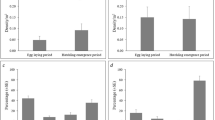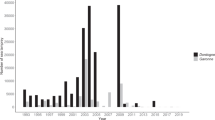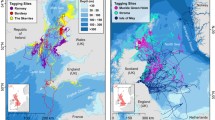Abstract
This study addresses the need for empirical data on the survival of sea turtle hatchlings after entry into the sea by (1) developing a method for measuring marine predation; (2) estimating predation rates while crossing the reef; and (3) investigating the effect of environmental variables on predation rates. Predation rates were quantified by following individual hatchlings, tethered by a 10m monofilament nylon line, as they swam from the water's edge towards the reef crest. Predation rates under particular combinations of environmental variables (tide, time of day, and moon phase) were measured in separate trials. Predation rates varied among trials from 0 to 85% with a mean of 31% (SE=2.5%). The simplest logistic regression model that explained variation in predation contained tide and moon phase as predictor variables. The results suggest that noctural emergence from the nest is a behavioral adaptation to minimize exposure to the heat of the day rather than a predator-escape mechanism. For the green turtle populations breeding in eastern Australia, most first year mortality is caused by predation while crossing the reef within the first hour of entering the sea.
Similar content being viewed by others
References
Anon (1990) Statistix 3.1. An interactive statistical program for microcomputers. Analytical Software, Minnesota
Balazs GH (1980) A synopsis of biological data on the green turtle in the Hawaiian Islands. NOAA Tech Mem NMFS-SWFC- 7:16–17
Balazs GH (1982) Growth rates of immature green turtles in the Hawaiian Archipelago. In: Bjorndal KA (ed) Biology and conservation of sea turtles. Smithsonian Institution, pp 117–126
Bjorndal KA, Bolten AB (1988) Growth rates of immature green turtles Chelonia mydas, on feeding grounds in the southern Bahamas. Copeia 1988:555–564
Bustard HR (1967) Mechanism of nocturnal emergence from the nest in green turtle hatchlings. Nature 214:317
Bustard HR (1972) Australian sea turtles. Their natural history and conservation. Collins, Sydney
Bustard HR, Greenham P (1969) Nesting behaviour of the green sea turtle on a Great Barrier Reef Island. Herpetologica 25:93–102
Carr A (1973) So excellent a fishe: a natural history of sea turtles. Anchor Natural History Books, New York
Carr A (1982) Notes on the behavioral ecology of sea turtles. In: Bjorndal KA (ed) Biology and conservation of sea turtles. Smithsonian Institution, pp 19–26
Carr A, Hirth H (1961) Social facilitation in green turtle siblings. Anim Behav 9:68–70
Collette BB, Talbot FH (1972) Activity patterns of coral reef fishes with emphasis on nocturnal-diurnal changeover. In: Collette BB, Earle SA (eds) Results of the tektite program: ecology of coral reef fishes. Nat Hist Mus Los Angeles Sci Bull 14:98–124
Crouse DT, Crowder LB, Caswell HA (1987) A stage-based population model for loggerhead sea turtles and implications for conservation Ecology 68:1412–1423
Ehrhart LM (1982) A review of sea turtle reproduction. In: Bjorndal KA (ed) Biology and conservation of sea turtles. Smithsonian Institution, pp 29–38
Fowler LE (1979) Hatching success and nest predation in the green sea turtle, Chelonia mydas at Tortuguero, Costa Rica. Ecology 60:946–955
Frazer NB (1983) Survivorship of adult female loggerhead sea turtles, Caretta caretta, nesting on Little Cumberland Island, Georgia, USA. Herpetologica 39:436–447
Frick J (1976) Orientation and behavior of hatchling green turtles (Chelonia mydas) in the sea. Anim Behav 24:849–957
Frith CB (1975) Predation upon hatchlings and eggs of the green turtle Chelonia mydas, on Aldabra Atoll, Indian Ocean. Atoll Res Bull 185:11–12
Goldman B, Talbot FH (1976) Aspects of the ecology of coral reef fishes. In: Jones OA, Endean R (eds) Biology and geology of coral reefs, vol III: Biology 2. Academic Press, New York, pp 125–154
Harry JL, Limpus CJ (1989) Low-temperature protection of marine turtle eggs during long-distance relocation. Aust Wildl Res 16:317–320
Hendrickson JR (1958) The green turtle, Chelonia mydas (L.) in Malaya and Sarawak. Proc Zool Soc London 130:455–535
Hendrickson JR (1980) The ecological strategies of sea turtles. Am Zool 20:597–608
Hirth HF (1971) Synopsis of biological data on the green turtle Chelonia mydas (Linnaeus) 1758. FAO Fisheries Synopsis 85:1–74
Hobson ES (1965) Diurnal-nocturnal activity of some inshore fishes in the Gulf of California. Copeia 1965:291–302
Johannes RE (1981) Words of the lagoon. University of California Press, Berkeley
Limpus CJ (1973) Avian predators of sea turtles in south-east Queensland rookeries. Sunbrid 4:45–51
Limpus CJ (1978) The reef In: Lavery HJ (ed) Exploration north. Richmond Hill Press, South Yarra, Victoria, pp 187–222
Limpus CJ (1982) The status of Australian sea turtle populations. In: Bjorndal KA (ed) Biology and conservation of sea turtles. Smithsonian Institution, pp 297–303
Limpus CJ (1989) Environmental regulation of green turtle breeding in eastern Australia. NOAA Tech Mem NMFS-SEFC 232:93–95
Limpus CJ, Walter DG (1980) The growth of immature green turtles Chelonia mydas under natural conditions. Herpetologica 36: 162–165
Limpus CJ, Parmenter CJ, Baker V, Fleay A (1983) The Crab Island sea turtle rookery in the north-eastern Gulf of Carpentaria. Aust Wild Res 10:173–184
Limpus CJ, Fleay A, Guinea M (1984) Sea turtles of the Capricornia Section, Great Barrier Reef Marine Park. In: Ward WT, Sanger P (eds) The Capricornia Section of the Great Barrier Reef: past, present and future. R Soc Qld Symp, pp 61–78
Limpus CJ, Reed PC (1985) The green turtle, Chelonia mydas, in Queensland: a preliminary description of the population structure in a coral reef feeding ground. In: Grigg GC, Shine R, Ehman H (eds) The biology of Australian frogs and reptiles. Surrey Beatty, Sydney, pp 47–52
Limpus CJ, Nicholls N (1988) The southern oscillation regulates the annual numbers of green turtles Chelonia mydas breeding around eastern Australia. Aust Wildl Res 15:157–161
McFarland WN (1991) The visual world of coral reef fishes. In: Sale PF (ed) The ecology of fishes on coral reefs. Academic Press, New York, pp 16–38
Meylan A (1982) Behavioral ecology of the West Caribbean green turtle Chelonia mydas in the inter-nesting habitat. In: Bjorndal KA (ed) Biology and conservation of sea turtles. Smithsonian Institution, pp 67–80
Miller JD (1985) Embryology of marine turtles. In: Gans C (ed) Biology of the reptilia, Vol 14. Wiley, New York, pp 271–328
Miller JD, Limpus CJ (1981) Incubation period and sexual differentiation in the green turtle Chelonia mydas L. In: Banks CB, Martin AA (eds) Proc Melbourne Herpetological Symposium. Zool Board Victoria, pp 66–73
Mortimer JA (1982) Factors influencing beach selection by nesting sea turtles. In: Bjorndal KA (ed) Biology and conservation of sea turtles. Smithsonian Institution, pp 45–52
Mrosovsky N (1968) Nocturnal emergence of hatchling sea turtles: control by thermal inhibition of activity. Nature 220:1339
Mrosovsky N (1971) Black vultures attack live turtle hatchlings. The Auk 88:672–673
Richardson JI, Richardson TH (1982) An experimental population model for the loggerhead sea turtle (Caretta caretta). In: Bjorndal KA (ed) Biology and conservation of sea turtles. Smithsonian Institution, pp 165–178
Ricker WE (1975) Computation and interpretation of biological statistics of fish populations. Bull Fish Res Board Canada
Salmon M, Wyneken J (1987) Orientation and swimming behavior of hatchling loggerhead turtles Caretta caretta L. during their offshore migration. J Exp Mar Biol Ecol 109:137–153
Shulman MJ (1985) Recruitment of coral reef fishes: effects of distribution of predators and shelter. Ecology 66:1056–1066
Siegel S (1956) Nonparametric statistics. McGraw-Hill, Sydney
Smith C, Lavett, Tyler JC (1972) Space resource sharing in a coral reef fish community. In: Collette BB, Earle SA (eds) Results of the tektite program: ecology of coral reef fishes, Natural Hist Mus Los Angeles Sci Bull, pp 125–170
Stancyk SE (1982) Non-human predators of sea turtles and their control. In: Bjorndal KA (ed) Biology and conservation of sea turtles. Smithsonian Institution, pp 139–152
Whitmore CP, Dutton PH (1985) Infertility, embryonic mortality and nest-site selection in leatherback and green sea turtles in Surinam. Biol Conserv 34:251–272
Witham B (1974) Neonate sea turtles from the stomach of a pelagic fish. Copeia 1974:548
Witherington BE, Salmon M (1992) Predation on loggerhead turtle hatchlings after entering the sea. J Herpetology 26:226–228
Wyneken J, Burke TJ, Salmon M, Pedersen DK (1988) Egg failure in natural and relocated sea turtle nests. J Herpetology 22:88–96
Author information
Authors and Affiliations
Rights and permissions
About this article
Cite this article
Gyuris, E. The rate of predation by fishes on hatchlings of the green turtle (Chelonia mydas). Coral Reefs 13, 137–144 (1994). https://doi.org/10.1007/BF00301189
Accepted:
Issue Date:
DOI: https://doi.org/10.1007/BF00301189




